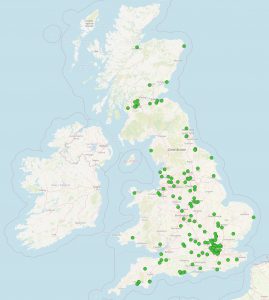Year 2 – Report 2021
Who is in the study?
We now have recruited a full cohort of 155 deaf young people. This is currently the largest longitudinal study in the world that is following up deaf young people in this specific age bracket.
The number is big enough for us to be able to carry out robust statistical analysis and to be confident about the trends in the data we report.

This is an important generation to understand because their life experience is very different from that of previous generations. Research evidence from deaf young people in former times may not be relevant in all respects to deaf youth today. This generation were the first to benefit from universal new-born hearing screening and early intervention from the first weeks of life. Their childhoods have coincided with advances in hearing technologies such as digital hearing aids and improved cochlear implants.
In the UK we have seen the formal recognition of BSL, with enhanced legal rights for BSL users in Scotland. It is also a time when BSL has become more commonplace in general society and deaf people feature regularly in popular media. This generation of deaf young people have grown up digital with the many possibilities of remote textual, spoken and visual communication as well as the shift to online worlds, friendships and interest groups through social media. What it is like to grow up deaf today may in some ways be very different from how it was 30 years ago.
Our cohort includes deaf young people with a wide range of audiological profiles, including 21 who are unilaterally deaf. Those with more severe degrees of deafness are over-represented in comparison with national data. The proportion of ‘non-white’ participants (22.62%) compares favourably with national population data on ‘non-white’ people from all ethnic backgrounds (12.8%) although there are not sufficient numbers in the cohort to consider the influence of specific ethnicity and heritage backgrounds.
The numbers of young people with additional needs (36.1%) and with one or more deaf parents (8%) matches well with expectations for these characteristics in deaf young people. The greater number of women (118) recruited in comparison with men is not unusual for studies of this age group, nor for longitudinal studies. Our sample is skewed toward those in the two highest Socio-Economic Status (SES) groups but not extremely so, as is often the case with sample populations of families with deaf children.
The READY baseline cohort is a more highly qualified group of deaf young people in comparison with general figures of deaf young people’s attainment at 16 to 19 years old. Whilst they are closer to the average to be expected from general population comparison data (with respect to GCSE and equivalent), a small number of the baseline cohort has reached year 11 without achieving any qualifications. So far, those participants from higher SES groups are doing better in post-GCSE qualifications but the strength of this association cannot be fully discerned until subsequent Wave results are analysed. Thirteen of the cohort are in paid employment currently, seven of whom are also in education/training.
